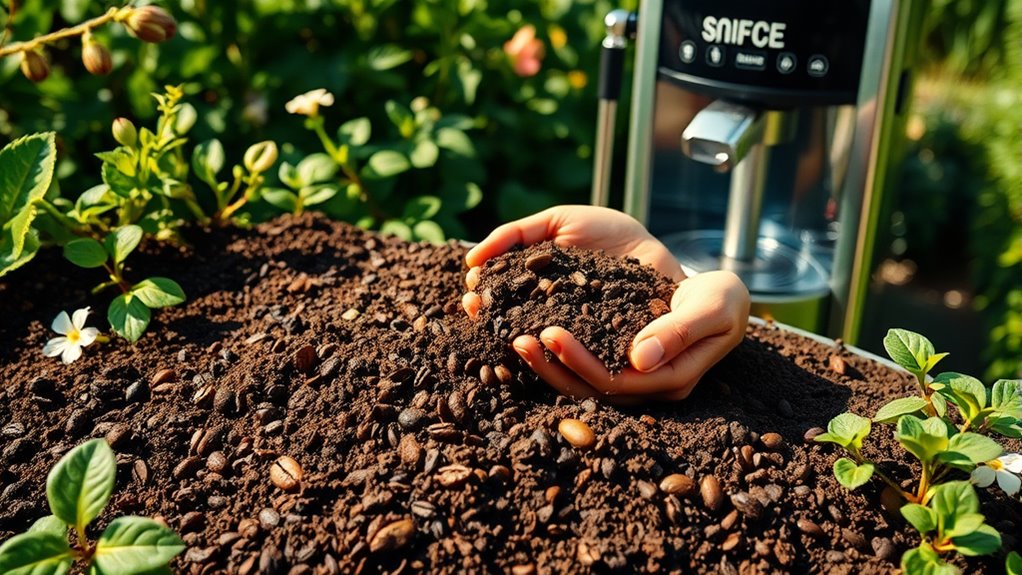To reduce coffee waste, many innovative approaches are being adopted. Used coffee grounds are repurposed as fertilizer, while companies transform them into energy solutions. Sustainable practices like compostable pods and smart coffee systems also help minimize landfill contributions. Dedicated recycling initiatives for coffee cups make a significant difference, too. By supporting eco-conscious brands and engaging with community efforts, you can be part of the solution. Discover more about the positive changes happening in the coffee industry!
Key Takeaways
- Used coffee grounds are repurposed as nitrogen-rich fertilizer, improving soil health and reducing waste.
- Innovative companies convert coffee grounds into energy solutions, promoting a circular economy and reducing carbon emissions.
- Dedicated recycling programs for coffee cups and pods enhance recycling rates beyond the current 5% benchmark.
- Smart coffee equipment and eco-friendly practices minimize waste generation and energy consumption in coffee production.
- Consumer support for sustainable brands encourages responsible sourcing and practices, fostering a greener coffee culture.
Overview of Coffee Waste Issue

As we drink our daily cups of coffee, it’s easy to overlook the staggering amount of waste generated by this beloved beverage.
In the UK alone, about 500,000 tonnes of coffee ground waste piles up annually, contributing to 1.8 million tonnes of carbon emissions when sent to landfill.
Additionally, coffee cups account for 30,000 tonnes of waste each year, with a shocking 182.5 million cups littered.
Coffee cups contribute a staggering 30,000 tonnes of waste annually, with an alarming 182.5 million cups ending up littered.
This issue is compounded by the alarming production of coffee pods, with 7 billion made annually—29,000 of which end up in landfill every minute.
With growing pressure to reduce coffee waste and carbon emissions, recycling initiatives are essential for a sustainable future in the coffee industry.
It’s time to take action.
The Impact of Coffee Pods

Coffee pods have become a popular choice for many coffee drinkers, but their environmental impact is alarming. Every minute, around 39,000 single-use coffee pods are produced, with 29,000 ending up in landfills. This massive waste contributes substantially to pollution.
Here’s what you should know:
- Only about 5% of coffee pods are currently recycled, highlighting a dire need for better recycling programs.
- Many pods are made from recyclable materials, but their mixed composition complicates proper disposal.
- Switching to compostable pods can greatly reduce your environmental footprint.
Utilizing Coffee Grounds

You might be surprised to learn that your used coffee grounds can be a valuable resource instead of waste.
By repurposing them as fertilizer, you can enrich your garden while cutting down on landfill contributions.
Plus, innovative companies are turning these grounds into sustainable energy solutions, showcasing how you can help create a circular economy in the coffee industry.
Fertilizer for Plants
While many people enjoy their daily cup of coffee, they mightn’t realize that the used grounds can be transformed into a powerful fertilizer for plants.
Coffee grounds are nitrogen-rich and can greatly enhance soil health. By utilizing them, you’re not just nourishing your plants but also reducing landfill waste.
Here’s how coffee grounds can benefit your garden:
- Improve soil structure and aeration
- Retain moisture for healthier plants
- Provide essential nutrients without harmful chemicals
Independent coffee shops often offer used coffee grounds for composting or as natural fertilizer.
By using coffee grounds, you’ll contribute to a more sustainable gardening practice while mitigating the carbon emissions associated with landfill disposal. Additionally, coffee grounds contain antioxidants that combat oxidative stress, further enriching your garden’s ecosystem.
Energy Generation Solutions
After exploring how used coffee grounds can enhance your garden, it’s time to contemplate their potential as an energy source. By repurposing coffee grounds, you not only contribute to sustainable practices but also reduce carbon emissions considerably. Bio-Bean in the UK is a prime example, turning waste coffee into ‘coffee logs’ for energy generation.
| Benefits of Utilizing Coffee Grounds | Impact on Environment |
|---|---|
| Reduces landfill waste | Lowers carbon emissions |
| Produces biogas via anaerobic digestion | Supports circular economy |
| Saves on waste disposal costs | Promotes sustainable practices |
Harnessing coffee grounds for energy generation is a smart choice, helping you save costs while protecting the planet. Embrace this circular economy approach!
Recycling Coffee Cups
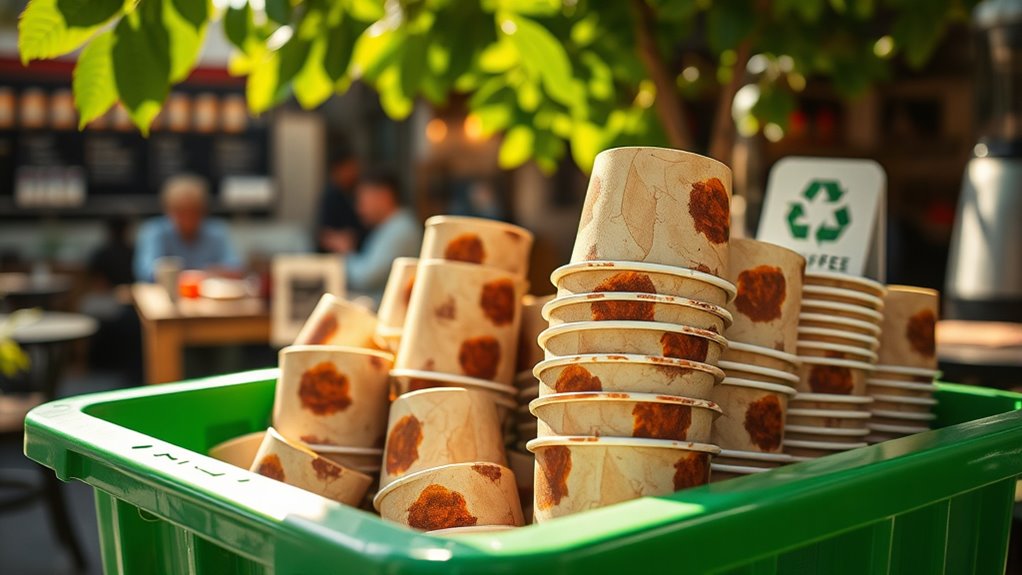
Recycling coffee cups is essential in tackling the staggering amount of waste generated each year, as the UK alone discards over 2.5 billion disposable cups.
Unfortunately, only 0.25% of these cups get recycled due to their wax or plastic lining.
A mere 0.25% of disposable coffee cups are recycled, hindered by their plastic or wax linings.
To improve coffee cup recycling, you can:
- Use dedicated coffee cup recycling bins instead of standard mixed recycling bins.
- Support waste collectors that specialize in collecting disposable paper coffee cups.
- Advocate for businesses to implement coffee cup recycling initiatives to enhance their environmental impact.
The recycling rate for coffee cups has improved, but there’s still much work to do.
Operational Changes for Waste Reduction
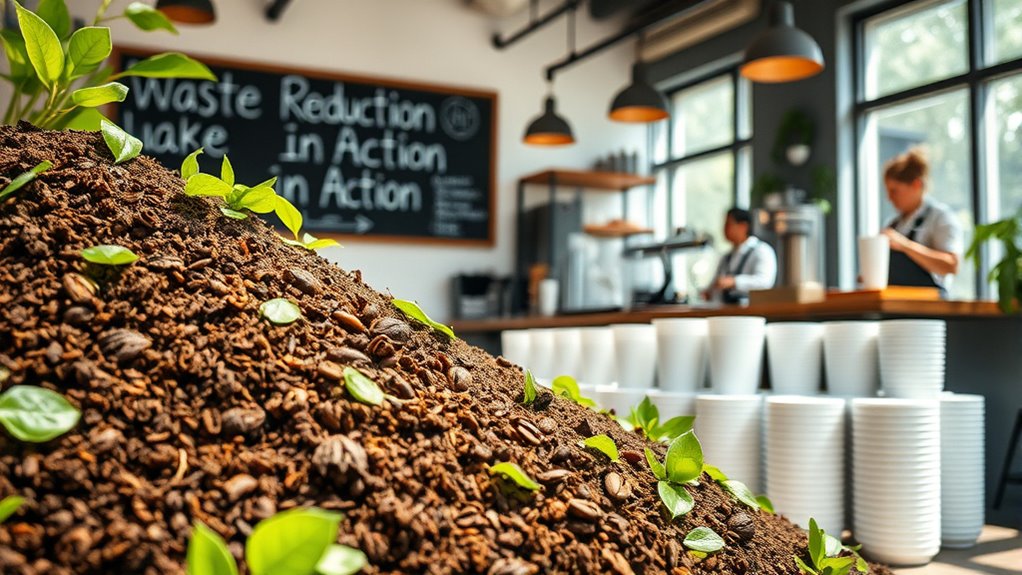
To reduce coffee waste, consider upgrading to smart coffee equipment that maximizes brewing efficiency and minimizes excess.
On-demand coffee dispensing systems can serve you fresh coffee cup by cup, eliminating the problem of leftover cold coffee. Additionally, understanding the mechanics of French press coffee can help you make more efficient brewing choices, reducing waste further.
These operational changes not only cut down on waste but also enhance your overall coffee experience.
Smart Coffee Equipment
While many coffee enthusiasts enjoy their daily brews, the environmental impact of traditional coffee equipment can’t be overlooked.
Smart coffee equipment is changing the game by enhancing operational control and reducing waste. Here’s how these advancements can help you:
- On-demand dispensing minimizes leftover coffee, ensuring freshness and reducing waste.
- Eco-Mode features lower energy consumption when machines are idle, aligning with your sustainability goals.
- Bulk packaging for coffee considerably cuts down on packaging waste compared to single-use options.
On-Demand Coffee Dispensing
Smart coffee equipment has paved the way for innovative solutions like on-demand coffee dispensing, which directly addresses the issue of waste. By providing fresh coffee cup by cup, these systems greatly reduce landfill waste from leftover cold coffee. You won’t have to brew large quantities that often go unused. With features like eco-mode, on-demand coffee dispensers also minimize energy consumption when idle, enhancing sustainability efforts. This shift aligns perfectly with campus sustainability initiatives, promoting environmental responsibility in institutions.
| Benefit | Description |
|---|---|
| Fresh Coffee | Brewed cup by cup, reducing waste. |
| Reduced Landfill Waste | Minimizes storage and disposal of unused coffee. |
| Lower Energy Consumption | Eco-mode features cut energy use considerably. |
| Sustainability | Supports environmental initiatives on campuses. |
Smart Coffee Systems
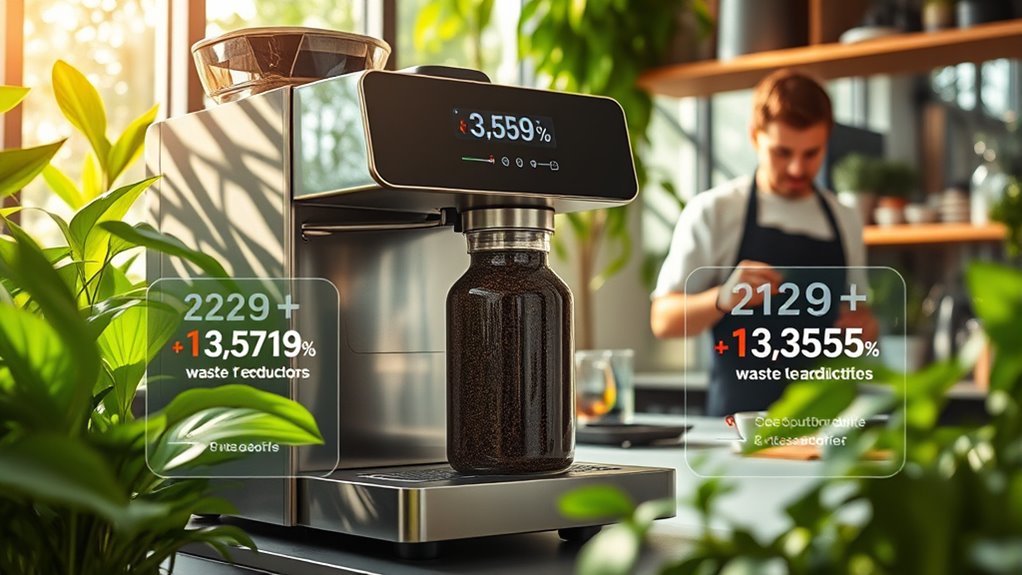
As coffee enthusiasts seek more sustainable options, innovative systems like Select Brew are making a significant impact on waste reduction.
These smart coffee systems minimize leftover cold coffee by dispensing coffee cup by cup, which means less waste and fewer large packaging needs.
Key benefits include:
- Eco-Mode features that lower energy consumption when not in use, enhancing sustainability.
- Utilization of nitrogen-rich grounds, which can be repurposed as valuable waste collectors for gardens.
- Support for sustainably certified coffee blends, promoting eco-friendly practices in the coffee industry.
Sustainable Sourcing Practices
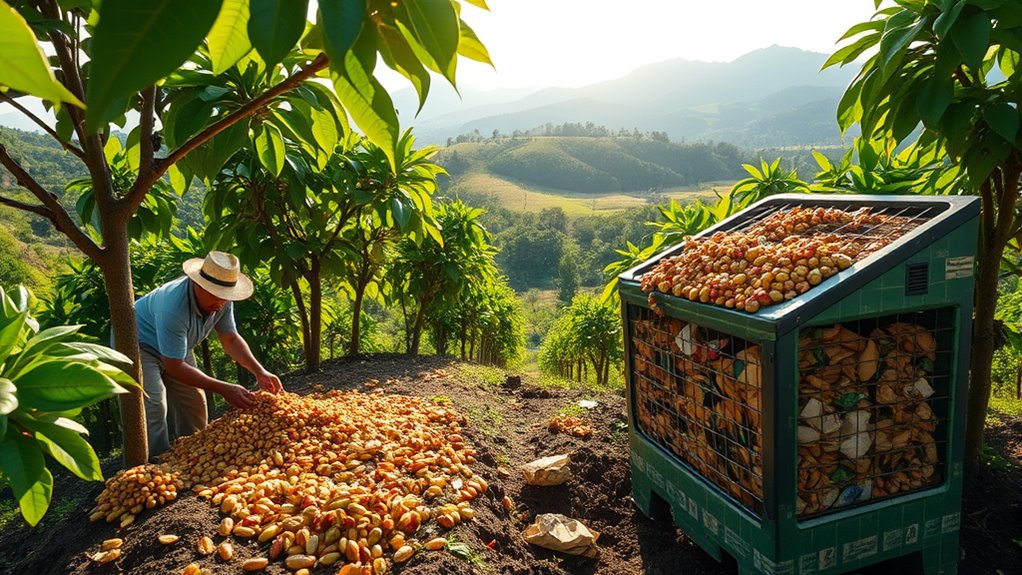
How can coffee lovers make a positive impact on the environment? By choosing brands that prioritize sustainable sourcing, you can support environmentally friendly coffee production.
Look for certifications like Fair Trade, Rainforest Alliance, or Organic, which guarantee that your coffee is responsibly sourced and benefits both farmers and ecosystems. Many roasters now focus on direct trade relationships, helping to secure fair prices and promote sustainable agricultural practices.
Additionally, opting for compostable coffee pods helps reduce waste and minimizes your carbon footprint. As you invest in these choices, you not only enjoy a better cup of coffee but also contribute to a more eco-conscious market, encouraging companies to adopt more sustainable practices.
Your choices really can make a difference!
Innovations in Coffee Waste Management
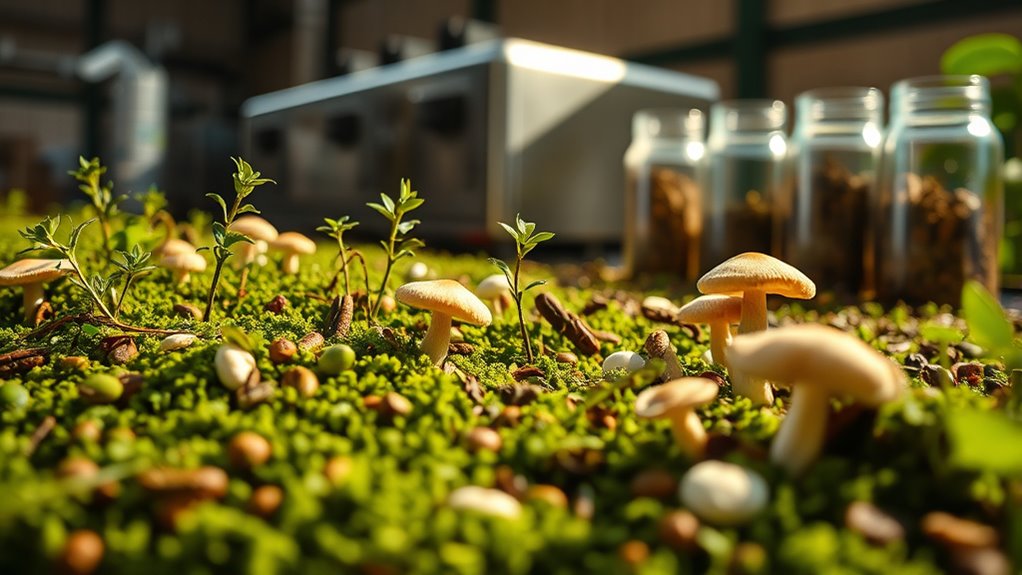
Innovations in coffee waste management are paving the way for a greener future. Here’s how you can contribute:
- Support companies like Bio-Bean, which transform used coffee grounds into energy-generating ‘coffee logs’, effectively reducing carbon emissions.
- Look for independent coffee shops that give away used coffee grounds for compost or plant fertilizer, promoting a circular economy.
- Choose fully compostable pods or those that are recyclable, addressing the environmental crisis of millions of pods ending up in landfills.
Additionally, these innovations contribute to waste management solutions, which not only enhance sustainability but also create economic opportunities within the coffee industry.
Community Engagement and Awareness

What role can you play in fostering a sustainable coffee culture?
You can actively participate in community engagement initiatives focused on recycling. By using dedicated coffee cup recycling bins and educating yourself about the environmental impact of coffee waste, you help increase recycling rates considerably.
Every minute, 39,000 coffee pods are produced, so raising awareness among friends and family about alternatives, like compostable pods and reusable cups, matters.
Local coffee shops are already repurposing coffee grounds as fertilizer, and you can support these efforts. When you choose businesses that prioritize sustainability, you contribute to reducing the 500,000 tonnes of coffee ground waste generated annually in the UK.
Together, you can save 104 million coffee cups from landfills each year.
Frequently Asked Questions
How to Reduce Coffee Cup Waste?
To reduce coffee cup waste, you can start by using a reusable mug instead of disposable cups.
Encourage your friends to do the same, creating a ripple effect. Look for cafes that offer discounts for bringing your own cup, and make it a habit to carry your mug wherever you go.
Additionally, support local initiatives that promote recycling and proper disposal of coffee cups, ensuring they don’t end up in landfills.
Every small action counts!
How Can Coffee Be Reduced?
You know what they say: “Waste not, want not.”
To reduce coffee waste, start by buying only what you need, ensuring freshness. Store your coffee in airtight containers to keep it safe from moisture.
When brewing, stick to precise recipes and use the right grind size to avoid unpleasant flavors.
Finally, consider composting leftover grounds; they’re great for your garden and cut down on waste.
Small changes can make a big difference!
How Can We Reduce the Impact of Coffee on the Environment?
You can reduce the impact of coffee on the environment by making a few simple changes in your daily routine.
Start using a reusable coffee mug to cut down on disposable cups. Opt for compostable coffee pods and support local recycling initiatives.
If you brew at home, consider investing in eco-friendly equipment that minimizes waste.
Finally, be mindful of your consumption, and explore options like on-demand coffee dispensing to reduce unnecessary energy use.
What Is the Least Wasteful Way to Make Coffee?
The least wasteful way to make coffee is by using whole beans and grinding them fresh. This way, you minimize coffee ground waste and avoid tossing out stale beans.
Opt for brewing methods like pour-over or French press, which produce less waste compared to single-use pods. Stick to a precise coffee-to-water ratio to prevent over-preparation, and use reusable filters to cut down on disposable waste.
Enjoy your fresh cup while being environmentally friendly!
Conclusion
As you sip your morning brew, remember that every cup can spark a change. By embracing innovative practices and reducing waste, you’re planting seeds for a greener future. With each coffee ground recycled and every cup repurposed, you’re weaving a tapestry of sustainability. Together, let’s turn the tide on coffee waste and brew a world where every drop counts. So, raise your mug not just for pleasure, but for a planet that thrives alongside your daily ritual.
